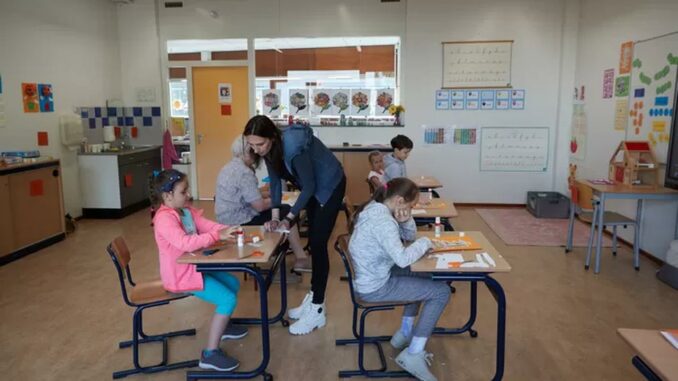
Ukrainian refugees class in Zutphen is running like clockwork
It was a nice surprise for the Lea Dasbergschool in Zutphen. When this school started a school class for Ukrainian refugees at the request of the municipality, a teacher who is Ukrainian herself came forward. Miss Iryna is now indispensable. “These children did not know that the Netherlands existed at all.”
This article is from the Stentor. Every day a selection of the best articles from newspapers and magazines appears on NU.nl. there you read here more about.
Miroslav of 5 is cutting and pasting. But Jana of 11 also participates in the cutting and pasting. They cut out the words kitchen, attic, bedroom, wall, roof and cupboard and stick them on a plate of a house. Every word in the right place, of course. After that, a movie starts on the IWB in which the parts of a house are again shown.
“Every day we start with a lot of language in such a way that it varies, so that it is manageable for all children,” says Rie Theus. She is one of the two teachers of this language transition class, a class especially for refugee children. The fact that it is such a special language transition class is thanks to colleague Iryna Shumakova.
Shumakova is a Ukrainian who has lived in the Netherlands for twenty years and has also been working in education all that time. “When I saw this vacancy, I thought, I want to do that. I was working at the Kompaan College at the time. Fortunately, I was able to switch quickly,” she says. The class of five Ukrainian children has been running since the May holidays.
‘They didn’t know that the Netherlands existed’
“One girl is here because her father was working here when the war broke out. The other children were first in Poland. It became too full there. The children said that suddenly three buses were ready, which went to all kinds of places in Europe. and that they had to choose where they got in. That one bus went to the Netherlands. They didn’t know that the Netherlands existed at all,” says Iryna.
Iryna now has a little time, because after they went through the language exercises at full steam, it is now time for a break. All five children play in the square between the Dutch children. Soon Jana and Katja come back in and ask Miss Iryna something in Ukrainian. She answers: ‘Can we also swing?’, because that was the question, how do you say that in Dutch.
“That mix is very important for the children,” says teacher Rie. “Sometimes another class comes here to do some tinkering. And they participate in gym class with their own peers. Because the idea is that they make the link from this class to the Dutch language. As soon as they have enough language skills, they continue in an ordinary class.”
Hands, Feet and Points
The big surprise is that Rie and Iryna don’t face class together every day. Iryna is fluent in both languages, but Rie cannot speak Ukrainian and two days a week Rie has to do without Iryna. “You’ll be amazed at how well you can communicate with hands, feet, pointing and pulling someone somewhere to show something.”
Rie also knows how it feels. She lived in Portugal for a few years. “And I didn’t speak a word of Portuguese. I know it costs them a lot of energy, because you always have to pay attention, what are they saying, what do they want from me.”
It also requires a lot of patience from both sides, says Rie. “You can mainly make things clear in the moment. So if they throw sand in the sandbox, you can tell them with gestures that you shouldn’t. But you don’t have to try that again later in class, then the context.”
And sometimes help from Google
“Especially in the first weeks, I sometimes grabbed my mobile, with Google Translate. Then you record something and hear the translation, very easy. Miroslav recently got really upset at school. And it just got to me. not clear what was going on. With help from the phone I found out that he had had a nightmare.”
The question arises to what extent the teachers have to deal with the war trauma of the children. “Not these kids,” says Iryna. “They fled immediately during the first bombings. They heard that, but saw no other bad things. Of course the panic and care of their parents, they really got that.”
After the summer holidays, eight more children will be added from a class at another school in Zutphen. “But how it will continue, how long they will stay and how many will be added. That is quite uncertain,” Iryna knows.
Education for refugee children
Education for refugee children is organized in many different ways. For example, there are children who directly participate in a regular class. Some secondary and primary schools have transition classes, so a separate class with a lot of attention for language, where the children sit temporarily until they have mastered the language enough to move on to a regular class. Sometimes a school is started near a reception location.

Be the first to comment